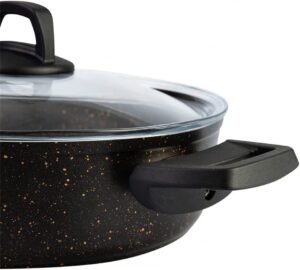 Granite cookware has become a favorite among both amateur and professional chefs in recent years. These pans and pots are a beautiful and practical alternative to the standard kind, being crafted from a mixture of natural minerals and impregnated with a non-stick coating. Granite has its advantages and disadvantages like any other cookware material. Here, we’ll take a look at the pros and cons of granite cookware so you can decide for yourself if it’s a good fit for your kitchen.
Granite cookware has become a favorite among both amateur and professional chefs in recent years. These pans and pots are a beautiful and practical alternative to the standard kind, being crafted from a mixture of natural minerals and impregnated with a non-stick coating. Granite has its advantages and disadvantages like any other cookware material. Here, we’ll take a look at the pros and cons of granite cookware so you can decide for yourself if it’s a good fit for your kitchen.
Benefits of Granite-Made Pots and Pans
- Physical appeal
The striking visual appeal of granite cookware is one of its main benefits. The granite-like speckles on these cookware items make them an eye-catching complement to any kitchen. With so many options, you can choose kitchenware that complements your existing colour scheme or that you simply find more aesthetically pleasing.
- Stick-Free Coating
Granite pots and pans feature a special coating that makes it impossible for food to stick to the surface when cooking. Because food can be wiped away without scraping or scrubbing, this feature facilitates both cooking and cleaning. Cooking with less unhealthy fats like oil or butter is made easier by the non-stick coating.
- Consistent Temperatures
Granite cookware is highly regarded for its consistent heat distribution. This results in more even cooking and less chance of food drying out or burning. When ingredients are cooked to the same temperature throughout, it results in more uniformly delicious meals.

- Durability
Because of the combination of minerals used in its construction, granite cookware is exceptionally hardy and long-lasting. These cookware pieces can usually tolerate regular usage without being damaged by scratches or chipping. Furthermore, granite cookware typically features a durable non-stick coating that ensures the cookware retains its performance over time.
- Versatility
Granite cookware may be used on the stovetop, in the oven, and even under the broiler. Because of this, granite cookware is a great investment because it can be used for so many various dishes.
Issues with Granite Cookware
- Weight
The heaviness of granite kitchen tools is a major downside. Heavy pots and pans made of granite are a result of the material’s utilization of natural minerals. For people with physical disabilities, this could make them more difficult to handle.
- Cost
Granite cookware is typically more expensive than other materials used for utensils. Granite cookware may be worth the extra money for some people because of how long it lasts and how well it performs, but it’s not necessarily the ideal choice for those on a tight budget.
- Non-Stick Performance May Not Be Reliable
The efficiency of the non-stick surface on granite cookware varies widely between manufacturers and particular products. Some consumers may be disappointed by the lack of non-stick performance in their granite cookware. If you want your non-stick cookware to last as long as possible and perform as well as possible, be sure to follow all care and usage recommendations provided by the manufacturer.
- Induction stove top compatibility is limited
Induction cooktops employ magnetic fields to heat cookware, however granite cookware is not always compatible with these surfaces. If your stove top uses induction cooking, you should make sure that the granite cookware you intend to purchase is compatible with your stove. You could also put money into a disc that is compatible with induction stoves that may be placed between the pot or pan and the hob.
- Needs for Upkeep and Repairs
In order to preserve its quality and non-stick functionality, granite cookware calls for specific attention and upkeep. Avoiding scratching the surface by using metal utensils and hand-washing the cookware instead of a dishwasher are two examples. For optimal performance, seasoning the cookware as directed by the manufacturer is also crucial.
Final Thoughts
In conclusion, granite cookware has several benefits for both amateur and expert chefs. It is a common choice because of its good looks, non-stick surface, equal heat distribution, durability, and adaptability. There are, of course, negatives to think about as well, such as the heavy weight, high price, potentially variable non-stick performance, restricted compatibility with induction cooktops, and the need for regular care and maintenance.
Your granite cookware needs and wants are what should guide your final decision. You can decide whether or not granite cookware is perfect for your kitchen by weighing the advantages and cons discussed below. Follow the manufacturer’s guidelines for usage and care to get the longest life out of your cookware and the greatest results in the kitchen.
Advice for Buying Granite Pots and Pans
When shopping for new pots and pans, here are a few more things to consider if you’ve determined that granite is the material for you:
- Think About the Size and Variety of Kitchen Utensils You’ll Require
Take into account the size of your family or household and the dishes you frequently prepare while making this decision. You may use this information to pick out the perfect granite cookware for your home. If you have a huge family and you cook for them frequently, for instance, you might want to get some really big pots and pans. However, smaller cookware may be more practical if you typically only feed yourself or a partner.
- Choose Reputable Manufacturers
The quality of granite cookware varies widely across different manufacturers. Do your homework on trustworthy companies and check reviews from other customers to make sure you’re getting high-quality cookware that will last and function well. Knowing which manufacturers have a history of creating high-quality granite cookware is essential.
- Verify Service and Warranty Information
When purchasing new cookware, having confidence in the product’s guarantee can be invaluable. The manufacturer’s confidence in the quality of their granite cookware can be gauged by the length and scope of the guarantee offered. If you anticipate having any issues with your cookware in the road, it will be helpful to pick with a company that offers reliable customer service.
- Give Sets and Pieces Separate Thought
Granite cutlery is available both individually and in sets. Buying a set of cookware as opposed to buying individual pieces of different sizes and styles can save money. It may be more cost-effective to purchase separate pieces of cookware if you only require a few different tools.
- Keep in Mind the Extras
It’s important to think about the tools you’ll need to care for and store your granite cookware when making the decision to buy it. Silicone or wooden utensils, for instance, can be purchased to avoid scratching the non-stick surface. It’s also a good idea to shield your counters and table surfaces from the heat of the cookware by using pot holders, trivets, or heat-resistant mats.
The benefits of granite cookware can be maximized by paying attention to the aforementioned details. To get the most out of your granite cookware and make sure it lasts as long as possible, you should always follow the instructions provided by the manufacturer. All the best with your meal prep!
